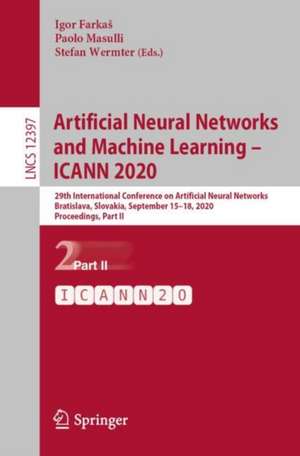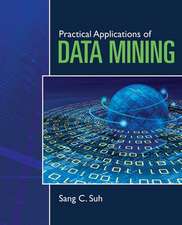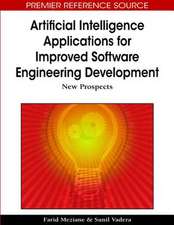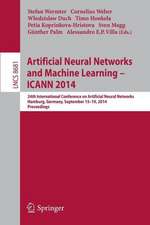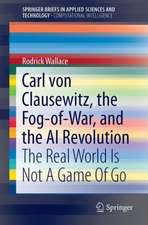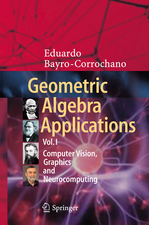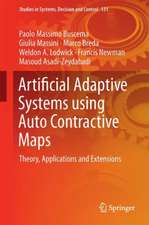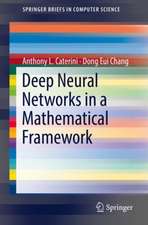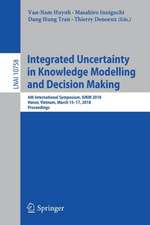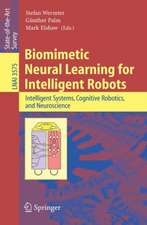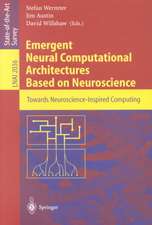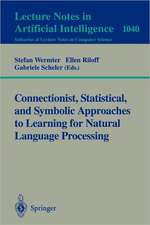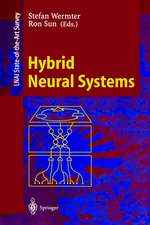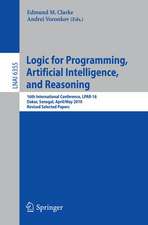Artificial Neural Networks and Machine Learning – ICANN 2020: 29th International Conference on Artificial Neural Networks, Bratislava, Slovakia, September 15–18, 2020, Proceedings, Part II: Lecture Notes in Computer Science, cartea 12397
Editat de Igor Farkaš, Paolo Masulli, Stefan Wermteren Limba Engleză Paperback – 17 oct 2020
*The conference was postponed to 2021 due to the COVID-19 pandemic.
| Toate formatele și edițiile | Preț | Express |
|---|---|---|
| Paperback (2) | 676.16 lei 6-8 săpt. | |
| Springer International Publishing – 20 oct 2020 | 676.16 lei 6-8 săpt. | |
| Springer International Publishing – 17 oct 2020 | 676.16 lei 6-8 săpt. |
Din seria Lecture Notes in Computer Science
- 20%
 Preț: 1061.55 lei
Preț: 1061.55 lei - 20%
 Preț: 340.32 lei
Preț: 340.32 lei - 20%
 Preț: 341.95 lei
Preț: 341.95 lei - 20%
 Preț: 453.32 lei
Preț: 453.32 lei - 20%
 Preț: 238.01 lei
Preț: 238.01 lei - 20%
 Preț: 340.32 lei
Preț: 340.32 lei - 20%
 Preț: 438.69 lei
Preț: 438.69 lei -
 Preț: 449.57 lei
Preț: 449.57 lei - 20%
 Preț: 343.62 lei
Preț: 343.62 lei - 20%
 Preț: 148.66 lei
Preț: 148.66 lei - 20%
 Preț: 310.26 lei
Preț: 310.26 lei - 20%
 Preț: 256.27 lei
Preț: 256.27 lei - 20%
 Preț: 645.28 lei
Preț: 645.28 lei - 17%
 Preț: 427.22 lei
Preț: 427.22 lei - 20%
 Preț: 655.02 lei
Preț: 655.02 lei - 20%
 Preț: 307.71 lei
Preț: 307.71 lei - 20%
 Preț: 1075.26 lei
Preț: 1075.26 lei - 20%
 Preț: 591.51 lei
Preț: 591.51 lei -
 Preț: 381.21 lei
Preț: 381.21 lei - 20%
 Preț: 337.00 lei
Preț: 337.00 lei - 15%
 Preț: 438.59 lei
Preț: 438.59 lei - 20%
 Preț: 607.39 lei
Preț: 607.39 lei - 20%
 Preț: 538.29 lei
Preț: 538.29 lei -
 Preț: 389.48 lei
Preț: 389.48 lei - 20%
 Preț: 326.98 lei
Preț: 326.98 lei - 20%
 Preț: 1414.79 lei
Preț: 1414.79 lei - 20%
 Preț: 1024.44 lei
Preț: 1024.44 lei - 20%
 Preț: 579.30 lei
Preț: 579.30 lei - 20%
 Preț: 575.48 lei
Preț: 575.48 lei - 20%
 Preț: 583.40 lei
Preț: 583.40 lei - 20%
 Preț: 763.23 lei
Preț: 763.23 lei - 15%
 Preț: 580.46 lei
Preț: 580.46 lei - 17%
 Preț: 360.19 lei
Preț: 360.19 lei - 20%
 Preț: 504.57 lei
Preț: 504.57 lei - 20%
 Preț: 172.69 lei
Preț: 172.69 lei - 20%
 Preț: 369.12 lei
Preț: 369.12 lei - 20%
 Preț: 353.50 lei
Preț: 353.50 lei - 20%
 Preț: 585.88 lei
Preț: 585.88 lei -
 Preț: 410.88 lei
Preț: 410.88 lei - 20%
 Preț: 596.46 lei
Preț: 596.46 lei - 20%
 Preț: 763.23 lei
Preț: 763.23 lei - 20%
 Preț: 825.93 lei
Preț: 825.93 lei - 20%
 Preț: 649.49 lei
Preț: 649.49 lei - 20%
 Preț: 350.21 lei
Preț: 350.21 lei - 20%
 Preț: 309.90 lei
Preț: 309.90 lei - 20%
 Preț: 122.89 lei
Preț: 122.89 lei
Preț: 676.16 lei
Preț vechi: 845.20 lei
-20% Nou
Puncte Express: 1014
Preț estimativ în valută:
129.40€ • 133.50$ • 109.52£
129.40€ • 133.50$ • 109.52£
Carte tipărită la comandă
Livrare economică 04-18 martie
Preluare comenzi: 021 569.72.76
Specificații
ISBN-13: 9783030616151
ISBN-10: 3030616150
Pagini: 891
Ilustrații: XXVII, 891 p. 402 illus., 247 illus. in color.
Dimensiuni: 155 x 235 mm
Greutate: 1.26 kg
Ediția:1st ed. 2020
Editura: Springer International Publishing
Colecția Springer
Seriile Lecture Notes in Computer Science, Theoretical Computer Science and General Issues
Locul publicării:Cham, Switzerland
ISBN-10: 3030616150
Pagini: 891
Ilustrații: XXVII, 891 p. 402 illus., 247 illus. in color.
Dimensiuni: 155 x 235 mm
Greutate: 1.26 kg
Ediția:1st ed. 2020
Editura: Springer International Publishing
Colecția Springer
Seriile Lecture Notes in Computer Science, Theoretical Computer Science and General Issues
Locul publicării:Cham, Switzerland
Cuprins
Model Compression I.- Fine-grained Channel Pruning for Deep Residual Neural Networks.- A Lightweight Fully Convolutional Neural Network of High Accuracy Surface Defect Detection.- Detecting Uncertain BNN Outputs on FPGA Using Monte Carlo Dropout Sampling.- Neural network compression via learnable wavelet transforms.- Fast and Robust Compression of Deep Convolutional Neural Networks.- Model Compression II.- Pruning artificial neural networks: a way to find well-generalizing, high-entropy sharp minima.- Log-Nets: Logarithmic Feature-Product Layers Yield More Compact Networks.- Tuning Deep Neural Network's hyperparameters constrained to deployability on tiny systems.- Obstacles to Depth Compression of Neural Networks.- Multi-task and Multi-label Learning.- Multi-Label Quadruplet Dictionary Learning.- Pareto Multi-Task Deep Learning.- Convex Graph Laplacian Multi-Task Learning SVM.- Neural Network Theory and Information Theoretic Learning.- Prediction Stabilityas a Criterion in Active Learning.- Neural Spectrum Alignment: Empirical Study.- Nonlinear, Nonequilibrium Landscape Approach to Neural Network Dynamics.- Hopfield Networks for Vector Quantization.- Prototype-Based Online Learning on Homogeneously Labeled Streaming Data.- Normalization and Regularization Methods.- Neural Network Training with Safe Regularization in the Null Space of Batch Activations.- The Effect of Batch Normalization in the Symmetric Phase.- Regularized Pooling.- Reinforcement Learning I.- Deep Recurrent Deterministic Policy Gradient for Physical Control.- Exploration via Progress-Driven Intrinsic Rewards.- An improved reinforcement learning based heuristic dynamic programming algorithm for model-free optimal control.- PBCS: Efficient Exploration and Exploitation Using a Synergy between Reinforcement Learning and Motion Planning.- Understanding failures of deterministic actor-critic with continuous action spaces and sparse rewards.- Reinforcement Learning II.- GAN-based Planning Model in Deep Reinforcement Learning.- Guided Reinforcement Learning via Sequence Learning.- Neural Machine Translation based on Improved Actor-Critic Method.- Neural Machine Translation based on Prioritized Experience Replay.- Improving Multi-Agent Reinforcement Learning with Imperfect Human Knowledge.- Reinforcement Learning III.- Adaptive Skill Acquisition in Hierarchical Reinforcement Learning.- Social Navigation with Human Empowerment driven Deep Reinforcement Learning.- Curious Hierarchical Actor-Critic Reinforcement Learning.- Policy Entropy for Out-of-Distribution Classification.- Reservoir Computing.- Analysis of reservoir structure contributing to robustness against structural failure of Liquid State Machine.- Quantifying robustness and capacity of reservoir computers with consistency profiles.- Two-Step FORCE Learning Algorithm for Fast Convergence in Reservoir Computing.- Morphological Computation of Skin Focusing on Fingerprint Structure.- Time Series Clustering with Deep Reservoir Computing.- ReservoirPy: an Efficient and User-Friendly Library to Design Echo State Networks.- Robotics and Neural Models of Perception and Action.- Adaptive, Neural Robot Control – Path Planning on 3D Spiking Neural Networks.- CABIN: A Novel Cooperative Attention Based Location Prediction Network Using Internal-External Trajectory Dependencies.- Neuro-Genetic Visuomotor Architecture for Robotic Grasping.- From Geometries to Contact Graphs.- Sentiment Classification.- Structural Position Network for Aspect-based Sentiment Classification.- Cross-Domain Sentiment Classification using Topic Attention and Dual-Task Adversarial Training.- Data Augmentation for Sentiment Analysis in English – the Online Approach.- Spiking Neural Networks I.- Dendritic computation in a point neuron model..- Benchmarking Deep Spiking Neural Networks on Neuromorphic Hardware.- Unsupervised Learning of Spatio-Temporal Receptive Fields from an Event-Based Vision Sensor.- Spike-Train Level Unsupervised Learning Algorithm for Deep Spiking Belief Networks.- Spiking Neural Networks II.- Modelling Neuromodulated Information Flow and Energetic Consumption at Thalamic Relay Synapses.- Learning Precise Spike Timings with Eligibility Traces.- Meta-STDP rule stabilizes synaptic weights under in vivo-like ongoing spontaneous activity in a computational model of CA1 pyramidal cell.- Adaptive Chemotaxis for improved Contour Tracking using Spiking Neural Networks.- Text Understanding I.- Mental Imagery-Driven Neural Network to Enhance Representation for Implicit Discourse Relation Recognition.- Adaptive Convolution Kernel for Text Classification via Multi-Channel Representations.- Text generation in discrete space.- Short text processing for analyzing user portraits: A dynamic combination.- Text Understanding II.- A Hierarchical Fine-Tuning Approach Based on Joint Embedding of Words and Parent Categories forHierarchical Multi-label Text Classification.- Boosting Tricks for Word Mover’s Distance.- Embedding Compression with Right Triangle Similarity Transformations.- Neural Networks for Detecting Irrelevant Questions during Visual Question Answering.- F-Measure Optimisation and Label Regularisation for Energy-based Neural Dialogue State Tracking Models.- Unsupervised Learning.- Unsupervised Change Detection using Joint Autoencoders for Age-Related Macular Degeneration Progression.- A fast algorithm to find Best Matching Units in Self-Organizing Maps.- Tumor Characterization using Unsupervised Learning of Mathematical Relations within Breast Cancer Data.- Balanced SAM-kNN: Online Learning with Heterogeneous Drift and Imbalanced Data.- A Rigorous Link Between Self-Organizing Maps and Gaussian Mixture Models.- Collaborative Clustering through Optimal Transport.
